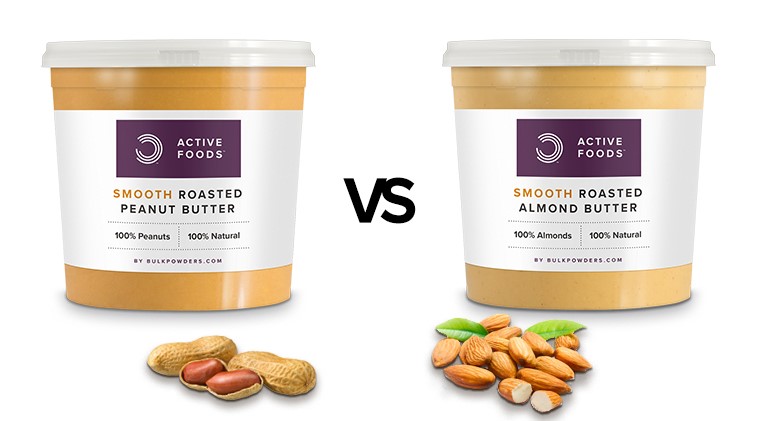Battle of the Nuts: Almond Butter vs Peanut Butter
Peanut butter is the reigning champion of good fats – just ask any Instagram fitness model or “gym culture humour page”. Peanut butter has been well-regarded for years due to its healthy fat matrix, versatility as a food and the fact it tastes way better than actual peanuts.
Almond butter is a recent contender and part of the trend of millennials to think that novel is always better. This has been an obvious trend due to the hype surrounding almond butter as being healthier than peanut butter (as ever, the internet doesn’t provide any reason for why).
We’re going to break down the two nut butters so you can weigh them up for your own dietary needs.
Why Should You Eat Nut Butters?
Nuts and seeds are the best plant foods for healthy fats – it’s well-known. The problem is that a lot of them taste like crap and eating the quantity you’d need to balance your macros is a mammoth task that only a small handful of paleo-lovers can stand.
Nut butters are an amazing and versatile way of getting these healthy fats into your diet without hating life or spending 60 minutes of your day choking down nuts. They can be mixed into a variety of meals and provide a great tool for many diets.
Peanut Butter: The Stats
Peanut butter is usually made out of peanuts (at least you’d hope so), some form of oil and brown sugar. There are some emulsifiers in cheaper brands, but natural peanut butter is seeing a huge boost in popularity. Our peanut butter is 100% natural, and contains purely 100% roasted whole peanuts.
Peanut butter is a classic because it provides healthy fats, plenty of calories (564 Kcal/100g), and is relatively filling due to the texture. It also provides a decent dose of protein, Vitamin E, B vitamins, magnesium and phosphorous. There’s no way around it: peanut butter is a great staple for dietary fats.
We can’t skip over the versatility and taste. Peanut butter tastes awesome and can be put in shakes, oats, sandwiches, on fruit or simply eaten by itself. This versatility is matched by very few other foods, especially when you control for the taste of peanut butter against, for example, avocado.
Almond Butter: The Contender
Almond butter is milder and more subtle than peanut butter most of the time, though they’re very similar in their use. The most obvious time to use almond butter is if you don’t like peanut butter, or you’re looking for slightly different nutritional values. When it comes to calories, almond butter provides 612 Kcal/100g, so marginally more than peanut butter.
To start with, almond butter has a much better ratio of unsaturated: saturated fats, meaning improved cardiovascular risk factors and general health benefits. This is great, but it comes at the cost of a much lower protein content: something that’s going to matter if you’re fitting nut butters into a cutting diet.
Almond butter also has high levels of B vitamins as well, with even higher concentrations of magnesium and phosphorus, as well as copper and manganese. Much like the comparison between sweet potatoes and regular potatoes, the comparison between almond and peanut butters is all about trade-offs.
Also, our Almond butter comes in kilo tubs and there’s even a dark chocolate flavour which is pretty dope – especially if you’re eating clean.
Variations: What’s the Score?
When we look at both of these nut butters, there is huge variation in the types that can be found and the way that they fit into your diet. The obvious first point is that you should be looking for the low-processing, high-nutrient varieties. These tend to be healthier and avoid the addition of unnecessary sugars and additives.
The real question is: crunchy or smooth? From a nutritional perspective, it’s another game of trade-offs. Crunchy peanut butter has higher fibre values, while smooth peanut butter has greater concentrations of micronutrients. Crunchy has better unsaturated fat content, but it also has a reduced protein count.
The fact is that these variations are mostly superficial: unless you’re eating 100g at a time, you’re not going to notice a huge practical difference in the choice of peanut butter or almond butter textures. If you are eating 100g of nut butter at a time you need to seriously evaluate your dietary choices: we understand, we just don’t approve it.
Blends are another great choice: we offer a triple nut butter (a 3 nut butter, if you will) that mixes cashews, almonds and hazelnuts to provide a more balanced nutritional profile. Plus, it tastes like hazelnut, which is always awesome. If you’re feeling fancy you can also try pistachio butter (eat your greens) or flavoured peanut butter– because who dares, wins.
4 Ways to Put Your Nuts to Work
So how can you work these excellent nut butters into your diet? We’ve included a few key ways of getting them involved, increasing your intake of good fats and making them count.
1.) Oatmeal
Mixing a spoonful of nut butter into your oatmeal can transform a breakfast – especially if it’s a flavoured protein nut butter (it exists and it’s awesome). Getting a huge breakfast is a good way to keep yourself going and nut butters and oats make for a great, slow-digesting breakfast.
2.) On Toast
Classic breakfast foods, simply whack a healthy dollop of nut butter on toast. If you’re using almond, you might want to combine it with another flavour like Zero Calorie Syrup™, preserves or fresh fruit.
3.) Protein Shake
On a diet that requires high calorie intake or need a thick recovery shake for a hard workout? A shake with almond or peanut butter in can make a serious difference to your intake. If you’re looking for something mild, try almond butter, whereas chocolate protein powder and peanut butter is a classic combination.
4.) As a Side?
A lot of dietitians and clean-eating social media accounts have popularised the notion of nut butters as a side to your meal. We’re not sold on this yet: using an unsweetened almond butter is a great choice as it won’t have the distinctive brown-sugar taste of many peanut butters.
Peanut vs Almond Butter: Is there a Winner?
The simple answer is no. As with everything else in diet, nutrition and human performance the only set answer is “it depends”. The two butters play a relatively similar role in the diet and have similar applications: they’re both good fats and make for versatile tools in your dietary toolkit.
There’s no clear winner here because they address the same problem and are both effective. Remember that a food is only healthy or unhealthy in relation to your whole diet, your goals, and the complete dietary context. Peanut butter is a clear staple and very popular, but almond butter (and variations thereof) are arguably more versatile.
If you’re indecisive or (somehow) don’t like peanut butter, the triple-nut butter, protein nut butters and the irresistible dark chocolate variations are going to make your life a lot easier.









